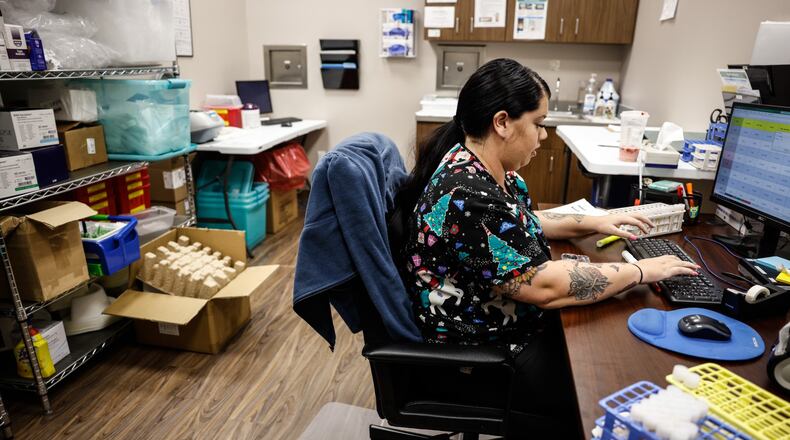Montgomery County ranked first in the state for the most overdose deaths per 100,000 residents in 2014, 2016 and 2017, but fell out of the top 10 in 2020 and 2021, according to the Ohio Department of Health.
The statistics from the most recent years are unofficial and work remains to stop overdose deaths, local health department officials warn.
“It’s the collaboration and willingness to work together amongst community partners to really make a difference and drive a change in those numbers,” said Casey Smith, program manager of Public Health-Dayton & Montgomery County’s Community Overdose Task Force. “We are coming together collectively and not duplicating services, rather we are mobilizing our resources and helping really making a difference.”
According to the CDC’s Provisional Drug Overdose Death statistics, the number of deaths from March 2020-2021 has risen more than 30% across the United States compared to March 2019-2020. In Ohio, the CDC stats show a 26% increase in overdose deaths.
Montgomery County saw a 5% increase in that time span, from 304 deaths to 320.
Officials have said the reasons behind the increases nationwide might have to do with the added stresses created by the COVID-19 pandemic, and difficulty getting rehabilitative services during lockdowns and social distancing requirements.
“Montgomery County was the overdose death capital of not just Ohio, but of the whole country,” said Dennis Cauchon, president of Harm Reduction Ohio, a nonprofit that tracks statewide overdose statistics. “The Dayton area has been (ranked higher) for a long time, but for the last couple of years relative to the rest of the state, overdose deaths have been falling. Even though it’s up, it’s far less than the rest of the state.”
What’s working?
In 2017, Montgomery County reported more than 500 accidental overdose deaths. National and international news crews came to Dayton to report what was going on, Cauchon said, and officials were forced to mobilize to get it under control.
Those numbers fell dramatically in 2018, when 275 deaths were reported to the state. In 2019, 266 deaths were reported. The accident overdose deaths ticked up to 309 in 2020 during the pandemic.
“Likely the decline is related to a very aggressive and fairly well-organized effort to distribute naloxone, to expand syringe programs, coming into contact with those in active use who might die,” Cauchon said.
Naloxone, also known by the brand name Narcan, can reverse the effects of an opioid overdose.
Part of getting on the right track was the opening of facilities like Brightview’s Garnet Drive location in 2018.
“It’s a combined, cumulative effort throughout the region, and Montgomery County has a really supportive recovery community,” said Renena Hale, Brightview’s community outreach manager. “A lot of use of Narcan is responsible for that as well.”
Brightview offers medical and clinical treatment, including intensive outpatient care and continued recovery options. Patients start their recovery on the first day they come to the center, which treats people from all over Montgomery County.
“We’re doing a really good job of offering and providing access to treatment,” Hale said, adding that Brightview’s treatment options are evidence-based. “Medication assisted treatment is responsible for saving lives.”
Credit: JIM NOELKER
Credit: JIM NOELKER
Montgomery County Sheriff’s Office Director of Criminal Justice Outreach Teresa Russell said the task force’s focus on removing lethal drugs from the community also has played a large role. The sheriff’s office works alongside other local agencies, removing thousands of grams of heroin and fentanyl from the streets since 2018.
“The other part I would say is community collaboration,” Russell said. “There has been so much effort put in by the Montgomery County Drug-Free Coalition, the prevention coalition, the Community Overdose Action Team. Everybody is actually working collaboratively to come up and identify problems and to solve them.”
Still work to be done
The data kept by the Ohio Department of Health and Public Health-Dayton & Montgomery have different overdoes death totals because they are not calculated the same way.
As of Dec. 1, the Ohio Department of Health reports that Montgomery County has had 236 deaths while the local health department is reporting closer to 300. The local department counts all overdose deaths that took place in Montgomery County while the state only counts residents of the county, officials said. Also, coroners across the state have several months to report their final totals, so all data should be considered preliminary.
There has been about a 5% increase in drug overdose deaths this year compared to this time last year, according to Public Health.
“There’s always more work to be done,” Smith said. “One life lost is one too many. And as long as we continue to see deaths related to overdoes, we still have work to do. We are continuing to address addiction as a disease rather than a moral failing. We know that addiction can affect anyone in the community.”
The health district will continue to monitor data, Smith said, and listen to stakeholders to address substance use in the community.
While the county rankings seem to be improving, a lot of people are still hurting in the community, Dayton Family of Addicts Executive Director Anita Kitchen said.
“It depends on how you take that stat — more deaths is more deaths, and it’s still a human life, and we are up from last year,” she said. “Not as high as 2017, and hopefully we never get to that point again because that was unbelievable. But we are still up. And that should raise an eyebrow and that is still a big problem.”
Credit: JIM NOELKER
Credit: JIM NOELKER
One battle that public health and safety officials continue to fight is the stigma around addiction, which might cause people to not seek treatment for fear of being labeled, Kitchen said.
“People need to not be criticized when they go get help, but feel they can get the support when they go and get help,” she said. “That’s a big reason people don’t go, is because of the stigma. I think we are chipping away at it, but we still have a ways to go.”
About the Author



